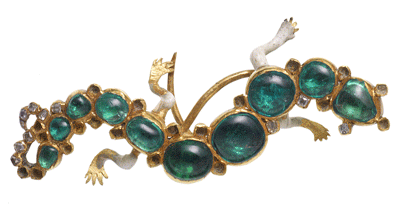At the Museum of London
Jonah Miller
In 1912 a group of workmen demolishing 30-32 Cheapside struck gold. They brought up more than 400 pieces of late Elizabethan and early Stuart jewellery, and sold them to an asthmatic pawnbroker cum museum agent, George Lawrence, a.k.a. Stoney Jack. The entire hoard is on display at the Museum of London until 27 April.
Stoney Jack made quite a profit, but doesn’t seem to have kept any pieces back for himself, which probably makes the last leg of the various journeys undertaken by the jewellery the least corrupt.In the early days of the East India Company, agents across Asia corresponded with London goldsmiths to make sure they bought according to the latest fashion. Hugh Greete complained loudly and endlessly that no one answered his letters so he didn’t know what to buy; it later emerged he was buying almost everything available with Company money, keeping the quality for personal use or sale, and sending the dregs back to the capital. Unscrupulous ship’s officers and customs men would pocket a few. Other pieces might be stolen on arrival in London. Or they might be displayed alongside counterfeits. In theory, the goldsmiths' guild had extensive powers to prevent forgery. In practice, dodgy stock was hidden and dodgy goldsmiths left town when the wardens came calling.Thomas Sympson, a respectable master craftsman, dyed rock crystals and sold them as rare gems. John Lynson was caught embezzling from his part-time job at the mint. And many goldsmiths doubled asbankers.
Alongside the pieces on display at the Museum of London are portraits of bodies drowning in gilt and glimmer. There are a few non-nobles, the wives of merchants and goldsmiths whose husbands could afford the paintings as well as the jewels. It was partly about early modern conspicuous consumption, but other reasons for wearing exotic jewels suggest the medieval world died hard. Amethysts guarded against evil thoughts and the vapours of wine (for the young), emeralds preserved memory and good sight (for the old) as well as protecting you from plague (for everyone). Stephen Bradwell, a doctor, prescribed the stones, but privately admitted he was unsure how their influence could escape their hard shells. Still, they were from places as far off as the Americas, so anything was possible. Anselm Beotius de Boodt, physician to the Holy Roman Emperor Rudolph II, put a toad on a red cloth and spent the night waiting for it to belch up the much coveted toadstone, actually the fossilised tooth of a huge Jurassic fish.

Comments
See the following: Jones, P., and L. T. Olsan, ‘Middleham Jewel’, Viator 31(2000), 249-29; Lightbown, R. V., Medieval European Jewellery (London, 1992), ch. 10; Evans, J., Magical Jewels (Oxford, 1922) and Bozoky, E., ‘Private reliquaries and other prophylactic jewels’, in S. Page, ed., The Unorthodox Imagination in Late Medieval Britain (Manchester, 2010), pp. 115-30. Or just google "medieval" and "gemstones"!
The Italian Renaissance produced some more refined Latin, more (but not the first) perspective in paintings, and a few technological advances that had all been already invented in China. Almost every intellectual innovation associated with the Renaissance should really be seen as beginning in the late Middle Ages.